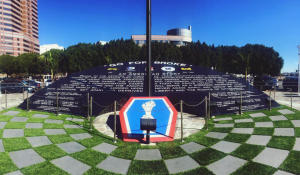- 初めに訪れた “Go For Broke Veterans Memorial” では、第二次世界大戦中に、歩兵連隊や知能部隊で仕えた二世の歴史をお話頂いた。記念碑の前で過酷な戦争下の様子を情熱的に語るのは、イタリア系アメリカ人のガイドさんだった。日系人が、戦争中に米国で残した忠実心の実は今日まで広い世代に語り継がれていた。そこから日本人として感じた入り混じった感情に、先祖への誇りは、日本の中学校や高校の歴史の授業で学んだ時とはまた違う視点で日本を見つめる事ができた。ここは是非リトル東京に来る事があれば訪れてほしいなと思った場所である。
- その後お伺いした “KIZUNA” では日系アメリカ人コミュニティにおける若い非営利組織の担う非常に重要な役割について学ぶことができた。KIZUNAはコミュニティ離れが懸念される四世の若者をコミュニティに積極的に入り組むための取り組みを教育を通して行っている。事実、若者主体でこの様な取り組みを行っているのは今のところKIZUNAのみであるようだ。KIZUNAのミッションは、「次世代の教育、エンパワメント、エンゲージメント(絆)を通してコミュニティの未来を築くこと」であり、プログラム参加を経てインターンをしに戻ってくる学生も少なくないくらい若者が地域社会に還元できる好循環のモデルがあるようだ。というのも、若者がKIZUNAでも、コミュニティの中でも、家族が増える様なコンセプトの中で帰属意識を持ってミッションの重要性を受け取ることができればコミュニティの一部として主体的に動き出すと確信をもって言っていたのである。そう言う意味で、KIZUNAのミッションの重要性は非常に多くの世代、人の間で共有されていているという事が言える。その共有された価値観やビジョンが今日のリトル東京を形作ってるのかなと個人的に感じた。最後に、お話を聞いた中で、「コミュニティの中核にあるのは、血統ではなく、その中で共有される文化と価値である。」という言葉が深く胸に残ったのでそれをシェアをしたい。必ずしも、日系アメリカ人の血統のみで組織されていないコミュニティ組織はとても包括的で「家族」というものを感じさせてくれるフレンドリーな環境そのもだった。それはとても魅力的だった。
- 最後に “Keiro Senior Care Facility” では、異文化で起こる人種差別についての生身の体験談を共有いただける機会に恵まれた。正直、流暢な英語で話す日系人のおばあちゃん、おじちゃんとの交流は初めての体験で、自分の持っていた日本人への固定概念が試された体験だった。戦後、アメリカに渡った日本人やその子孫の直面した差別のお話しを聞いて胸が痛くなった場面もあったが、人種差別問題が様々な形で浮上しているこの世の中で、異文化理解は真剣に考えなくてはならな問題である事だとわたしは受け止めた。どの世代でも解決されていない大きな社会問題だからこそ、そのような問題をディスカッションし、この機会を経て私たちが学べたように次世代に教育する事の大切さを学んだ。特に内輪からその変化をもたらすために今日ばかりの学びで終わらせたくないなと感じた。
- Early in the morning, we got to visit “Go For Broke Veterans Memorial” which commemorates Japanese Americans who served in the United States Army during World War Ⅱ. A young Italian-American man passionately shared us stories of which Japanese ancestors went through during the war. The incredible bravery and fidelity of Japanese American soldiers during the World War Ⅱ was something that has spreat throughout generations and what we heard and felt there personally allowed me to see Japan with a different point of view, in a way that I possibly couldn’t do in History class back in school. I highly recommend you to experience the memorial tour that will change your view as Japanese forever.
- In the noon, we had the privilege to visit “KIZUNA”, to join the founder, Mr. Craig Ishii for lunch to learn about the important roles the organization plays for Japanese Americans youth empowerment within the community. KIZUNA offers educational programs focused on leadership to involve the forth-generation Japanese Americans back to the community to further enhance youth engagement. In fact, KIZUNA seems to be the only organization to engage the youth into community mainly with the work of young Japanese American leaders. KIZUNA’s mission is; to build a future for the Japanese American community through the education, empowerment and engagement of the next generation and there seemed to be a great growth model in how the participants return to the organization for internship positions where they spent their youth. Like the founder, Mr. Craig said, KIZUNA works in a concept of “family” where youth can be part of the movement and that they understand the importance of the mission. This way, more and more young participants of the program have returned to the organization as Japanese American leaders in the community. From this point, it can be said that the importance of the mission is shared and valued among different generations and people, which I believe, that it is what has made what the Little Tokyo is today. Last but not least, I’d like to share a coment that striked me about today’s Japanese American Community in Little Tokyo, Los Angeles; Our community is not so much about the blood but more about the value and the culture that is shared inclusively with people. Although I came all the way from Japan and met many Japanese Americans for the first time, I truly felt at home in KIZUNA and in Little Tokyo. I don’t want to take this feeling of home for granted as I believe it is the product of a tremendous hard work of our ancestors and where their heart is at. I’m so grateful for the awesome people I got to meet and for the countless things I got to learn here.
- At the end of the day, we got to visit “Keiro Senior Care Facility” to enjoy the cultural exchange with Senior Japanese Americans and there I got to hear their cultural experience about their journey from Japan to America. It felt so new for me to meet the seniors who’s so fluent in English despite their Japanese look and in a way it broke the stereotypes I previously had about Japanese people; acknowledging that despite the language, culture and the age difference, they are still Japanese, whom I associate myself to. Some of the people shared their racial discrimination experience during and after the war. It broke my heart hearing their stories but I took the importance of cross-cultural understanding very seriously for I consider it to be a problem that has never been reconciled in humanity. Like many of the news we see today on the media is about the conflict of different groups of people, I learned the value of passing of the stories to the coming generations to educate to make a change. It had a great impact on me and I felt so encouraged to learn more about it through life.
Go For Broke Veterans Memorial in Little Tokyo, Los Angeles, CA

